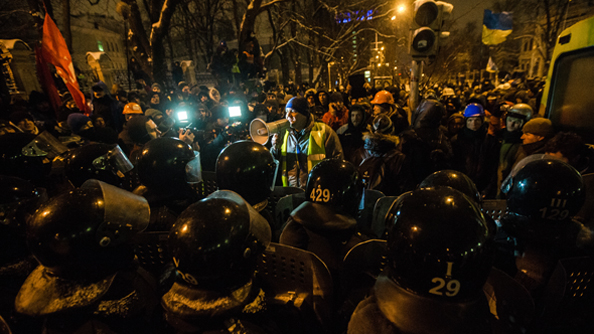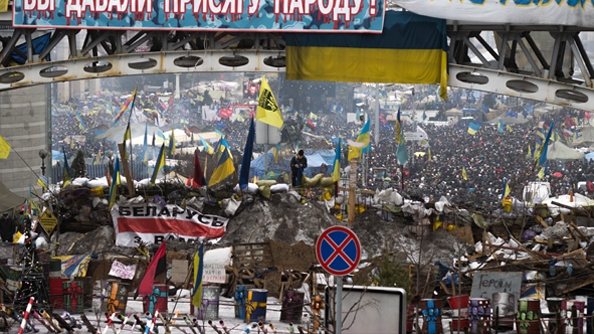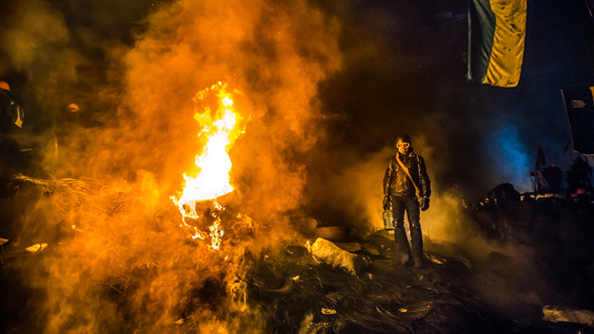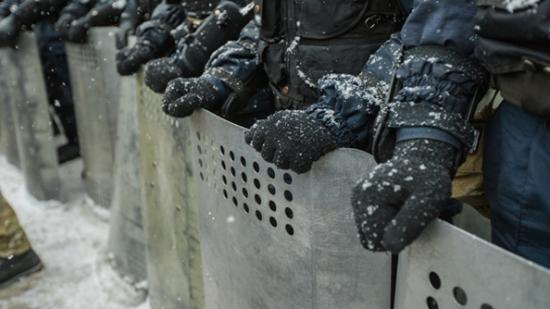In the first part of this series developers and members of the eSports scene explained how the Ukrainian games industry’s growth was stunted by heavy taxes and a corrupt government. Now: the revolution, and how it changed the perspective of the country’s developers.
On the evening of 22 November, Cradle lead developer Ilya Tolmachev sat in his office, a small room in a converted Soviet Union munitions factory. That night his president, Viktor Yanukovych, had rejected a trade deal with the European Union that might have brought his country back from the brink of bankruptcy. Ilya was furious.
“I was in a bad mood thinking about the consequences. Then I spotted a post from Mustafa Nayem, an outspoken Ukrainian journalist and critic of the regime. His post said ‘Enough complaining. If there is at least 1,000 of us ready to go out on the street let’s do that’.”
“The number of people responding saying ‘I’m ready, I’m ready, I’m ready’ was increasing dramatically and fast.”
Ilya Tolmachev was joined at Maidan Nezalezhnosti, the main square in Kiev, Ukraine’s capital city, by 2,000 protesters.
Over the next four months, a million Ukrainians would join the protests. Yanukovych’s government would fall, at the cost of over 100 lives.
I’m sat in Ilya’s office. It’s typical of the area – old industrial spaces are used to house the modern work of building videogames. Two minutes walk down the road are Vostok Games, developers of Survarium. They’re housed in a converted Soviet research facility. 4A games, creators of the Metro series, work out of an old school.
“The only thing that kept people away from going out to the streets was his promising to get Ukraine towards Europe,” Ilya tells me. “This was the only thing.”
Many Ukrainian developers look west for their future. 4A were backed by Western money: the US with THQ first, before Germany’s Koch Media stepped in after THQ’s bankruptcy. 4A’s success shows what could be possible if Ukraine began a more vigorous trading relationship with the EU. It could provide the Ukrainian games industry the stability it needs to expand.
But rather than taking the trade association, Yanukovych accepted a $20 billion bailout from Russia.
Protests sprung up over the country. “Me and my friends,” Maxym Hryniv, a developer at Mokus Games, tells me, “decided to go to the main square of our city of Lviv to show our position. On the first day, in my city, there were about 200 people, not much, but this was how the protest started.
“After one week it looked like the protest would end: we had never trusted our president and this association with the EU had always sounded like it was too good to be true. Then, in the capital in Kiev, the student protest was brutally dispersed by the police forces.”
On 30 November several hundred Berkut riot police attempted to clear the square using tear gas and batons. More than a hundred people required hospital treatment.

IMG_6178 by Sasha Maksymenko
Maxym knew what he had to do. “We decided to go immediately to Kiev. We didn’t have any plans, we just wanted to stop this somehow. It’s not right when police can beat students.”
When Max arrived in Kiev the number of protesters had swelled from the 2,000 on the first night to “around one million people on Maidan.”
At this point, Maidan remained a peaceful protest. While the police presence was heavy, they hadn’t opened fire.
4A’s Dean Sharpe remembers what happened next: the police got the provocation they needed.
“I remember one day I was coming out from the metro and there were about 30 titushkas all in black with baseball bats and motorcycle helmets,” Dean tells me.
“These were not the good guys, they were going to get on the metro and go to Maidan. I’m coming out as they’re going in. I just put my head down and thought ‘This is not good.’ They were going to go and start shit to give the government reason to start shooting people.”
The titushkas were a mercenary group created during Yanukovych’s administration. They were agitators, sent in “to start a giant fight to give the riot police a reason to come in,” Dean explains. “They would start shit so the protesters had to fight back and the police had a reason to interject.”
After the Titushka raids, the protestors realised they had to change their tactics. They began to build barricades and sealed off the square. “At that time when the student protest was dispersed there were no barricades, nothing at all,” explains Max. “The police had shields and we had nothing.”
The first barricades were built from wood, trolleys, tires, anything that could form a barrier between the protesters and the police. Later the protesters would use hammers and crowbars to pull up the paving stones and make walls.

View on Independence Square by Christiaan Triebert
Not everyone thinks it was just the police using titushkas.
“It was peaceful but then the Right Sector, the nationalists, they took the opportunity to take over,” Alex Nogin, manager of eSports team Synergy tells me. “At first they blended in and kept pushing, and pushing, and pushing. When the riots began, the people who were there at the beginning, who started it, they were like ‘What’s going on? We didn’t come for this. This isn’t our goal. Who are the people on Maidan today?’
“[The original protesters] didn’t want to start what they did. All the violence, all the blood, all the death, it pushed them away from those ideas from Maidan. It was a takeover, a revolution. I don’t know how to explain it. It was horrible. I had everything in my backyard and I was trying to avoid involvement because once you get involved that’s it.”
Even though the Maidan protests only took up a small part of the city, the main square in the centre, it was on everyone’s mind. The protests impacted on day to day work-life.
“Even if people weren’t at the protests they were trying to help someone at the protests or reading news like crazy,” says Sergey Galyonkin, who was working on Space Rogue at Red Beat at the time of the protests. “We had one guy who had to go and free his friend from the police station because he was captured. He was captured but not officially detained. It was unlawful. So he picked a lawyer, went to the police office and tried to free him. It was chaos at the police station because a lot of people were detained like this.”
And events could turn for the worse at any moment.
“There were a couple of moments when something bad was starting to happen and they’d call a red alert, calling for people across the city to come and help,” said Oleg Yavorsky, marketing director at Vostok Games.” It would be night time and taxi drivers would take people free of charge, getting them to the centre. The police would be cordoning off the centre trying not to let anyone filter through. At some points it was really worrisome. What was going to happen?”
On the 22 January the police began firing on protesters. Three people were killed in the first three days.
“The shootings were a shock.” Sergey says. “In all the time since the 90s we never had anything like that. We had protests in 90s and in 2004, the Orange Revolution, nobody ever shot. You don’t shoot your own people. Never before in Ukraine’s history have we had a ruler who shoots his own people except under the Soviet Union.”
The protesters adapted to this new threat by starting fires. “We’re about 10km from the centre so we don’t hear it,” Vostok Games’ lead designer, Aleskey Sytianov, explains. “But every time you move home or to work you constantly saw police road blocks or from the bridge I saw a distant fire in the centre.”

IMG_5939 by Sasha Maksymenko
Ilya was in the thick of the crowd when the police began firing. “It was at the moment when Hrushevskoho Street was in flames. We helped deliver the car tyres to keep up the flames.”
There was a strange sense of shared purpose: “People would come alone where they’d then unite into groups. It wasn’t like going to a concert with friends.”
“The peculiarity was that people didn’t make friends,” recalls Ilya. “They would arrive and start doing something straight away, deliver something, help, or whatever. You come there and you see someone prying up the pavement stones and you come with a plastic bag and put it in front of him and he starts instantly to put stones into your bag, you put it on your back and you ask someone to correct your hood and someone just does it for you and then he returns to his work and you carry your bag of stones to the destination. Some sort of instant collaboration. Just like ants.
Not all the activity on Maidan was defensive. As well as building barricades the protesters started to make molotov cocktails to throw at police vehicles, driving them back from the square. As well as kerosene and acetone, polystyrene was broken down and added to the mix. The resultant fire was hot enough to burn through the armour of an APC.
It was aggressive activity like this which has divided those opposed to Yanukovych’s government. Both Sergey and Alex said that they avoided taking part in the protests because of the violence on both sides.
But they helped in other ways. Most of the developers I met had donated money or delivered supplies to the protesters. “I was only at a couple of protests but I helped money donation-wise and medicine donation-wise,” Ievgen Dubravin, manager of the eSports team Na’VI, says.
“Social media groups and small websites [were set up] where listings were made and where to bring it. There was even a website where monetary donations were made and tracked where they were all going.
“There’s a couple of spots on Maidan directly and people know where to find them. So if you know you need to take this set of warm socks – because it was in the winter – and canned food to point A there are lists available where you can get that information.”
“My wife was helping one organisation who were setting up hospitals around Kiev,” Vitalli ‘V1lat’ Volochai, an eSports caster, told me. “People were messaging on Facebook saying ‘We need this, this, this, and this’. My friends and I had a car so we were getting all these messages from my wife and we were riding all this stuff to the hospital.”
Another way people helped was by forming ‘self-defense groups’. These groups would patrol areas outside of the centre, watching for activity by the police or ready to intervene if any fights started between pro-government and anti-government groups.
The employees and regulars of the city’s largest cyber cafe, CyberArena, formed a self-defense group to help out at the protest. “We had a World of Tanks team camping here,” says Vitalli. “Lots of people who played World of Tanks were getting together here at CyberArena and going to Maidan from here.”
Then, on the 18 February events came to a head. Snipers took up position above the square and began targeting protesters. It was a massacre: over 100 dead in three days.
“We were close to leaving on that day,” say Dean. He lives less than a kilometre away from Maidan. “We were hearing the gunshots from where I live. It was on the news. It was disturbing and disgusting because it was a live webcam. I was eating breakfast and it looked like something you’d see in a movie but we could hear the gunshots at the same time.”
“You saw people dropping and I thought ‘This isn’t right.’”
The attacks spurred others to action. Since the major violence began in Kiev, Maxym had stayed in his home city, Lviv. He joined a civil guard and patrolled the city instead of returning to the capital. “I was too scared and I didn’t know what to do,” he explains. “We don’t have the right to own guns. When people just get shot on the street I had no idea how to defend ourselves, how to defend other people.”
But on the 18 February, when the news reached Lviv, Max got a text. “My friend told me, ‘You have to go here to the police station’.” They barged in as part of a crowd.
Some broke into the armoury. They raided it of its pistols and shotguns. “I think [the plan] was to transfer them to Kiev, to give people the possibility to defend themselves.”
But Max doesn’t know what happened to the guns. “That was actually the last day of the protests. The next two days we started to build something new. The revolution ended, and there was nothing to do with them.”
Since Maidan, the police have held an amnesty. “I don’t believe all the guns were given back,” says Max. “[But] all this death in the revolution could not be possible in a country where regular people have the right to have guns. When people can defend themselves police cannot attack people.
“It may sound weird but sometimes the weapon can make people more peaceful.”
